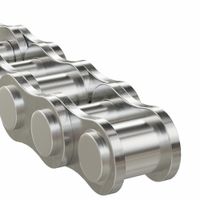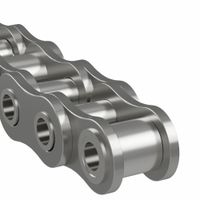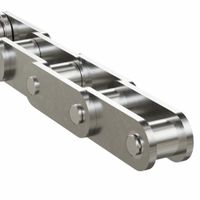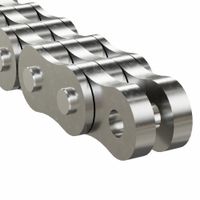Call +(254) 703 030 000 / 751 483 999 / 721 704 777
- Home
- Power Transmission
- Roller Chains Sprockets
- Roller Chains
.....Read More
Frequently Asked Questions
What are the different types of roller chains?
Roller chains are categorized based on their design, application, and construction. Here are the main types:
1. **Standard Roller Chains**: These are the most common type, used in a wide range of applications. They consist of a series of cylindrical rollers held together by side links. They are typically used in industrial machinery, conveyors, and agricultural equipment.
2. **Double Pitch Roller Chains**: These chains have a pitch that is twice the length of standard roller chains. They are lighter and more economical, suitable for applications with longer center distances and lower loads, such as conveyors.
3. **Heavy-Duty Roller Chains**: Designed for high-load applications, these chains have thicker side plates and are made from stronger materials. They are used in heavy machinery and equipment where durability is crucial.
4. **Leaf Chains**: Composed of stacked plates and pins, leaf chains are used in applications requiring high tensile strength, such as forklifts and hoists. They do not have rollers and are not used for power transmission.
5. **Silent Chains**: Also known as inverted tooth chains, these have teeth that mesh with sprockets, providing a quieter operation. They are used in applications where noise reduction is important, such as automotive engines.
6. **O-Ring Chains**: These chains have O-rings between the inner and outer links to retain lubrication and keep out dirt. They are commonly used in motorcycles and other outdoor equipment.
7. **Corrosion-Resistant Chains**: Made from materials like stainless steel or coated with special finishes, these chains are used in environments where corrosion is a concern, such as food processing or marine applications.
8. **Attachment Chains**: These chains have extended pins or plates for attaching fixtures or parts, used in conveyors and material handling systems.
Each type of roller chain is designed to meet specific operational requirements, ensuring optimal performance in various applications.
How do you measure roller chain size?
To measure roller chain size, follow these steps:
1. **Pitch Measurement**: Measure the distance between the centers of two consecutive roller pins. This is the pitch, typically measured in inches or millimeters. Common pitches include 1/4", 3/8", 1/2", etc.
2. **Roller Diameter**: Measure the diameter of the roller. This helps in identifying the chain series and compatibility with sprockets.
3. **Inner Width**: Measure the width between the inner plates where the sprocket teeth engage. This is crucial for determining the chain's compatibility with the sprocket.
4. **Overall Width**: Measure the total width of the chain, including the outer plates. This is less commonly used but can be helpful for specific applications.
5. **Link Count**: Count the number of links in the chain if you need to determine the chain length or replace it.
6. **Chain Number**: Use the pitch and other measurements to identify the chain number, often found in standards like ANSI (American National Standards Institute) or ISO (International Organization for Standardization). For example, an ANSI #40 chain has a 1/2" pitch.
7. **Check for Wear**: Measure the elongation by comparing the chain length to a new chain of the same size. Excessive elongation indicates wear and the need for replacement.
8. **Consult Standards**: Refer to standard charts or manufacturer specifications to confirm the chain size based on your measurements.
By accurately measuring these dimensions, you can determine the correct roller chain size for maintenance, replacement, or new installations.
What is the difference between ANSI and ISO roller chains?
ANSI (American National Standards Institute) and ISO (International Organization for Standardization) roller chains differ primarily in their standards, dimensions, and applications.
1. **Standards and Origin**:
- ANSI roller chains are governed by the American National Standards Institute, primarily used in North America.
- ISO roller chains follow international standards set by the International Organization for Standardization, used globally.
2. **Dimensions**:
- ANSI chains typically have a larger pitch and roller diameter compared to ISO chains of the same nominal size. This can result in ANSI chains being slightly heavier and potentially stronger.
- ISO chains have a more standardized dimension across different countries, facilitating international compatibility.
3. **Applications**:
- ANSI chains are often used in industries and machinery within the United States and Canada, where ANSI standards are prevalent.
- ISO chains are preferred in international markets and industries that require compliance with global standards.
4. **Interchangeability**:
- Due to dimensional differences, ANSI and ISO chains are not always interchangeable. Careful consideration is needed when replacing or integrating chains in machinery designed for a specific standard.
5. **Strength and Durability**:
- ANSI chains may offer higher strength due to their larger dimensions, but this is not a strict rule as material and manufacturing quality also play significant roles.
- ISO chains are designed to meet a balance of strength and compatibility across different regions.
6. **Availability**:
- ANSI chains are more readily available in North America, while ISO chains are more common in Europe and other parts of the world.
In summary, the choice between ANSI and ISO roller chains depends on regional standards, specific application requirements, and the need for international compatibility.
How do you maintain and lubricate roller chains?
To maintain and lubricate roller chains effectively, follow these steps:
1. **Inspection**: Regularly inspect the chain for signs of wear, rust, or damage. Check for elongation, which can indicate wear, and ensure the chain is properly tensioned.
2. **Cleaning**: Clean the chain to remove dirt, debris, and old lubricant. Use a brush and a mild solvent or a chain cleaner. Avoid using water as it can cause rust. After cleaning, dry the chain thoroughly with a cloth.
3. **Lubrication**: Choose the right lubricant based on the operating environment. Use oil-based lubricants for general purposes, while synthetic or specialty lubricants are better for extreme conditions. Apply lubricant to the inside of the chain where the rollers and pins make contact.
4. **Application**: Apply lubricant while the chain is warm and moving slowly, if possible. This helps the lubricant penetrate the chain's internal components. Use a drip, spray, or brush method to ensure even coverage.
5. **Excess Removal**: Wipe off any excess lubricant to prevent dirt accumulation. Excess lubricant can attract dust and debris, leading to increased wear.
6. **Tension Adjustment**: Ensure the chain is properly tensioned. A chain that is too tight can cause excessive wear, while a loose chain can lead to slippage or derailment.
7. **Alignment**: Check the alignment of the chain and sprockets. Misalignment can cause uneven wear and reduce the chain's lifespan.
8. **Environment Consideration**: Adjust maintenance frequency based on the operating environment. Chains in dusty or wet conditions may require more frequent cleaning and lubrication.
9. **Record Keeping**: Maintain a log of maintenance activities, including inspection dates, cleaning, lubrication, and any adjustments made. This helps in tracking the chain's condition and planning future maintenance.
Regular maintenance and proper lubrication extend the life of roller chains, ensuring efficient and reliable operation.
What are the applications of conveyor roller chains?
Conveyor roller chains are integral components in various industries due to their efficiency in material handling and transportation. Here are some key applications:
1. **Manufacturing and Assembly Lines**: Conveyor roller chains are used to move products between different stages of production, ensuring a smooth and continuous workflow. They are essential in automotive, electronics, and appliance manufacturing for transporting parts and assemblies.
2. **Food and Beverage Industry**: These chains are employed in processing, packaging, and bottling operations. They handle raw materials, move products through cooking or cooling processes, and transport packaged goods to distribution areas, often designed to meet hygiene standards.
3. **Mining and Quarrying**: In these industries, conveyor roller chains transport heavy loads of raw materials like coal, ores, and aggregates. They are built to withstand harsh conditions and heavy-duty operations.
4. **Agriculture**: Used in equipment like combine harvesters and grain elevators, conveyor roller chains help in the efficient movement of crops and agricultural products, facilitating processes like threshing, sorting, and storage.
5. **Warehousing and Distribution**: Conveyor systems equipped with roller chains are crucial for sorting, moving, and distributing goods in warehouses. They enhance the efficiency of logistics operations by automating the movement of packages and pallets.
6. **Textile Industry**: Conveyor chains are used in textile manufacturing for processes like dyeing, printing, and finishing, where they transport fabrics through various treatment stages.
7. **Recycling and Waste Management**: These chains are used in sorting and processing facilities to move recyclable materials and waste, aiding in efficient material recovery and disposal.
8. **Airport Baggage Handling**: Conveyor roller chains are part of the systems that transport luggage from check-in counters to loading areas, ensuring timely and organized baggage handling.
These applications highlight the versatility and importance of conveyor roller chains in enhancing operational efficiency across diverse sectors.
How do leaf chains differ from standard roller chains?
Leaf chains differ from standard roller chains primarily in their design and application. Leaf chains are constructed using interlaced link plates and pins, without the use of rollers. This design provides high tensile strength and flexibility, making them ideal for applications involving lifting and hoisting, such as in forklifts, cranes, and material handling equipment.
In contrast, standard roller chains consist of a series of cylindrical rollers held together by side links. These chains are designed for power transmission and are commonly used in machinery and conveyor systems. The presence of rollers reduces friction and wear when the chain engages with sprockets, making them suitable for high-speed and high-load applications.
Leaf chains are typically composed of stacked link plates, which are connected by pins. The absence of rollers allows for a compact design, enabling them to handle heavy loads in a vertical orientation. This makes them particularly effective in environments where space is limited, and high load capacity is required.
Standard roller chains, on the other hand, are more versatile in terms of speed and direction of movement. They are used in a wide range of applications, from bicycles to industrial machinery, where the transmission of power is the primary function.
In summary, the key differences between leaf chains and standard roller chains lie in their construction and intended use. Leaf chains are designed for lifting and hoisting with high tensile strength, while standard roller chains are optimized for power transmission with reduced friction and wear.
What are the advantages of using plastic roller chains?
Plastic roller chains offer several advantages:
1. **Corrosion Resistance**: Unlike metal chains, plastic roller chains are resistant to corrosion, making them ideal for use in environments exposed to moisture, chemicals, or saltwater.
2. **Lightweight**: Plastic chains are significantly lighter than their metal counterparts, which can reduce the overall weight of machinery and equipment, leading to energy savings and easier handling.
3. **Low Noise**: The material properties of plastic help in reducing noise levels during operation, which is beneficial in environments where noise reduction is critical.
4. **Low Maintenance**: Plastic roller chains do not require lubrication, which reduces maintenance time and costs. This also eliminates the risk of contamination from lubricants in sensitive applications like food processing.
5. **Chemical Resistance**: They are resistant to a wide range of chemicals, making them suitable for use in harsh chemical environments where metal chains might degrade.
6. **Non-Conductive**: Plastic chains are non-conductive, which is advantageous in applications where electrical insulation is necessary.
7. **Cost-Effective**: Generally, plastic roller chains can be more cost-effective than metal chains, especially when considering the reduced maintenance and longer lifespan in certain applications.
8. **Flexibility and Customization**: Plastic can be molded into various shapes and sizes, allowing for greater flexibility in design and customization to meet specific application needs.
9. **Reduced Wear and Tear**: Plastic chains tend to cause less wear on sprockets and other components, extending the life of the entire system.
10. **Environmentally Friendly Options**: Some plastic chains are made from recyclable materials, offering an environmentally friendly option for industries looking to reduce their carbon footprint.




